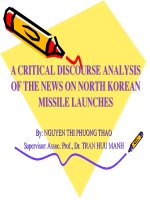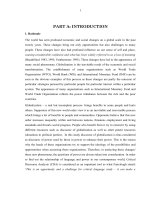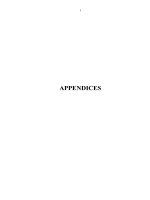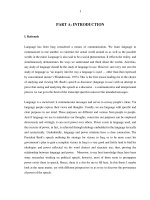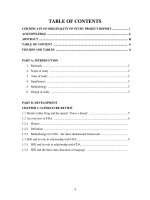A critical discourse analysis of the u s president barack obama’s inaugural speeches in 2009 and 2013
Bạn đang xem bản rút gọn của tài liệu. Xem và tải ngay bản đầy đủ của tài liệu tại đây (2.16 MB, 129 trang )
MINISTRY OF EDUCATION AND TRAINING
HANOI OPEN UNIVERSITY
M.A. THESIS
A CRITICAL DISCOURSE ANALYSIS OF
THE U.S PRESIDENT BARACK OBAMA’S
INAUGURAL SPEECHES IN 2009 AND 2013
(PHÂN TÍCH DIỄN NGÔN PHÊ PHÁN BÀI PHÁT BIỂU
NHẬM CHỨC CỦA TỔNG THỐNG MỸ BARACK OBAMA
NĂM 2009 VÀ 2013)
NGUYỄN THU TRANG
Hanoi, 2016
MINISTRY OF EDUCATION AND TRAINING
HANOI OPEN UNIVERSITY
M.A. THESIS
A CRITICAL DISCOURSE ANALYSIS OF
THE U.S PRESIDENT BARACK OBAMA’S
INAUGURAL SPEECHES IN 2009 AND 2013
(PHÂN TÍCH DIỄN NGÔN PHÊ PHÁN BÀI PHÁT BIỂU
NHẬM CHỨC CỦA TỔNG THỐNG MỸ BARACK OBAMA
NĂM 2009 VÀ 2013)
NGUYỄN THU TRANG
Field: English Language
Code: 60220201
Supervisor: Do Kim Phuong, Ph.D.
Hanoi, 2016
Front hard cover
Back hard cover
NGUYỄN THU TRANG
ENGLISH LANGUAGE
2014 - 2016
i
CERTIFICATE OF ORIGINALITY
I, the undersigned, hereby certify my authority of the study project report
entitled A critical discourse analysis of the U.S president Barack Obama’s
inaugural speeches in 2009 and 2013 submitted in partial fulfillment of the
requirements for the degree of Master in English Language. Except where the
reference is indicated, no other person’s work has been used without due
acknowledgement in the text of the thesis.
Hanoi, 2016
Nguyen Thu Trang
Approved by
SUPERVISOR
Do Kim Phuong, Ph.D.
Date:……………………
ii
ACKNOWLEDGEMENTS
I owe special debts of gratitude to my lecturers, colleagues, family and friends
for their support in my completing the thesis.
I would like to express my deepest gratitude to my supervisor, Do Kim
Phuong, Ph.D. for her advice, critical comments and invaluable suggestions.
My heartfelt sense of gratitude goes to my family for their emotional support
in accomplishing this graduation thesis.
Hanoi, 2016
Nguyen Thu Trang
iii
ABSTRACT
The thesis aims at exploring how power and ideology are achieved through
language via the analysis of the inaugural speech in 2009 and 2013 by U.S
President Barack Obama using one of the discourse analysis approaches –
critical discourse analysis. Firstly, the research maps out the theoretical
framework of CDA, the concepts of power and ideology and then examines
the importance of Systemic Functional Grammar (SFL) to CDA. Accordingly,
the framework of CDA procedure which sets the basis for the analysis of the
two inaugural speeches will be analyzed and interpreted. The analysis consists
of three stages namely: description, interpretation and explanation. The
findings and the conclusion of the thesis prove the author’s assumption about
the ideological power relations in the speech.
iv
LIST OF ABBREVIATIONS
CDA
Critical Discourse Analysis
CL
Critical Language
MR
Members’ Resources
SFG
Systemic Functional Grammar
App.
Appendix
v
LIST OF FIGURES AND TABLES
List of figures and tables
Figure 1:
The triangle of discourse analysis: language,
Page number
9
practice and context
Figure 2:
Interpretation
15
Figure 3:
Explanation
16
Figure 4:
Aspects of interpersonal management
18
Figure 5:
Components of multiple theme
19
Table 1:
The occurrence of personal pronoun in the two
35
speeches
Table 2:
Number and percentage of passive and active
37
sentences used in the speeches
Table 3:
The words with high frequency of using throughout
44
the two inaugural speeches by Barack Obama
Table 4:
Summary of transitivity analysis
48
Table 5:
Summary of thematization analysis
49
Table 6:
Summary of the findings
62
vi
LIST OF APPENDICES
Appendix 1:
Barack Obama’s inaugural speech on January 21, 2009
Appendix 2:
Barack Obama’s inaugural speech on January 21, 2013
Appendix 3:
Passive clauses and frequency of modality found in the speeches
Appendix 4:
Transitivity analysis
Appendix 5:
Speeches before and after the inaugural speeches in 2009 and 2013 of
President Barack Obama
vii
TABLE OF CONTENTS
Contents
Page
number
Certification of originality
i
Acknowledgements
ii
Abstract
iii
List of abbreviations
iv
List of figures and tables
v
List of appendices
vi
CHAPTER 1: INTRODUCTION
1
1.1.
Rationale
1
1.2.
Aims of the research
2
1.3.
Specific objectives of the research
2
1.4.
Scope of the research
2
1.5.
Significance of the research
3
1.6.
Structure of the research
3
CHAPTER 2: LITERATURE REVIEW
5
2.1.
Review of previous studies
5
2.2.
Review of theoretical background
6
2.2.1. Theoretical framework
6
2.2.2. Theoretical background
6
2.2.2.1. Critical discourse analysis (CDA)
9
2.2.2.2. Concepts in CDA
12
viii
2.2.2.3. CDA framework
12
2.2.2.4. Systemic Functional Grammar (SFL) in CDA
16
2.2.2.5. Discourse and power
19
2.3.
Summary
21
CHAPTER 3: METHODOLOGY
22
3.1. Research –governing orientation
22
3.1.1. Research questions
22
3.1.2. Research setting
22
3.1.3. Research approaches
22
3.1.4. Principles/Criteria for intended data collection and
data analysis
3.2. Research methods
23
23
3.2.1. Major method
23
3.2.2. Data collection techniques
23
3.2.3. Data analysis techniques
24
3.3. Summary
24
CHAPTER 4: A CRITICAL DISCOURSE ANALYSIS
OF THE U.S PRESIDENT BARACK OBAMA’S
INAUGURAL SPEECHES IN 2009 AND 2013
4.1. Textual analysis
26
4.2. Analysis in terms of vocabulary used
27
4.3. Analysis in terms of grammar features
35
4.3.1. The use of personal pronoun
35
4.3.2. The use of voice
37
26
ix
4.3.3. Mode of sentence
39
4.3.4. Modality
40
4.3.5. Cohesive devices
43
4.3.6. Transitivity
47
4.3.7. Thematization
49
4.3.8. Macro-structure of the text
50
4.4. Interpersonal processes
55
4.4.1. Situational context
55
4.4.2. Intertextual context
58
4.5. Explanation
59
CHAPTER 5: CONCLUSION
61
5.1. Recapitulation
61
5.2. Concluding remarks
62
5.3. Limitations of the current research
64
5.4. Recommendations/suggestions for further research
64
REFERENCES
66
CHAPTER 1: INTRODUCTION
1.1.
Rationale
The U.S President Barack Obama is a powerful person of high
position. He was elected the 44th president of the U.S on November
3, 2008 as the first African American to hold the office. Obama’s
campaign was marked by his eloquent speeches, passionate
supporters and worldwide fanfare for the Democratic candidate.
Through his speech, Barack Obama appeals millions of enthusiastic
supporters with his compelling rhetoric and charismatic presence. He
is the one who realizes the power of language more than anyone else.
In the President speeches, important political speeches, each word,
each structure is chosen as function of ideological communicative
presuppositions and implications.
Looking deep into his speeches, attempt to see the biased models and
socially shared, it is clear that President Obama strategically produces
the discourse on line, word by word, sentence by sentence. All choice
of vocabularies, lexical, arguments and many other features of
discourse structure in his speeches strategically index his ideology.
Especially, his inaugural speeches on January 21, 2009 and 2013
shows his power and ideology at most as he won sufficient delegates
in the Democratic Party primaries to receive the presidential
nomination.
In order to find out how effective language can be in expressing ideas
or ideologies, in other words, to find out the relationship between
language and power, critical discourse analysis (CDA) is considered as
an important tool as what Fairclough stated: This is an opportunity and
1
a challenge for critical language study - it can make a considerable
contribution on issues which are vitally important for the future of
humankind.
For the above reasons, the author conducts the research entitled A
critical discourse analysis of the U.S president Barack Obama’s
inaugural speeches in 2009 and 2013.
1.2. Aims of the research
The research aims at presenting an analysis of the U.S President
Barack Obama’s inaugural speeches under the light of critical
discourse analysis. Accordingly, the study suggests implications for
linguistics strategies which are used by speaker to get his ideologies
and power across.
1.3. Specific objectives of the research
Firstly, the research describes the linguistic features of the speech
basing on the theory of Fairclough on critical discourse analysis.
Lastly, the study suggests the power and ideology of President
Obama hidden behind words and shows how language is used to
embody power and the relation between them.
1.4. Scope of the research
Regarding academic scope, the study focuses on the critical discourse
analysis of the President Obama’s inaugural speech in 2009 and 2013.
Regarding social scope, this research focuses on his inaugural
speeches in 2009 and 2013.
2
1.5. Significance of the research
Regarding the theoretical significance, critical discourse analysis has
drawn much attention from linguistics for years. Linguists who find
interest in this field are making efforts to describe the concepts of
critical discourse analysis and to enhance the consciousness of how
power and ideology are embedded in language in particular and the
relation between language and society in general.
Regarding practical significance, this study is expected to raise a
voice in applying and advancing critical discourse analysis in doing
linguistic research. Also, it is a contribution to find out the role of
language in maintaining and attaining power and ideology of the
politician Barack Obama. The results of the study, therefore, hope to
make readers more aware of the powerful strength of language in the
ideology structure in order to achieve more equality and more power
in contemporary society.
1.6.
Structure of the research
The thesis is designed into 5 chapters:
Chapter 1 is the introduction of the thesis that deals with rationale,
aims, specific objectives, scope and significance of the study.
Chapter 2 introduces the literature review that being in charge of
reviewing previous studies on critical discourse analysis of the U.S
President Barack Obama’s first inaugural speech. At the same time,
theoretical background presents the theories used in the study
including the definition of discourse analysis and critical discourse
analysis, key concepts in critical discourse analysis, discourse and
power and Systemic Functional Grammar in critical discourse
analysis.
3
Chapter 3 is the methodology that indicates methods which are used
in the study to analyze data.
Chapter 4 is the findings and discussions showing the result of the
study. The analysis of data and the findings are both indicated in this
chapter.
Chapter 5 is the conclusion that summarizes major findings and
provides concluding remarks of the above chapters.
4
CHAPTER 2: LITERATURE REVIEW
2.1.
Review of previous studies
There are many studies on discourse analysis of the U.S President
Barack Obama’s speech. Among them, a study named A critical
discourse of Barack Obama’s speeches, 2010 by Junling Wang,
School of Foreign languages, Lanzhou, China is the one that using the
theory of M.A.K Halliday - systemic functional language (SFL) in
critical discourse analysis to analyze the speech and to show readers
the ideology and power of the President. Also, the data of the study is
the first inaugural speech of the President Barack Obama.
In the study, the author divides SFL in two components: systemic and
functional grammar. The study analyzes the speeches basing on
Halliday’s
theory
on
meta-functions
including
ideational,
interpersonal and textual function. The ideational function is
represented in text by transitivity. The table 2-3 (p.3) shows the
statistics of basic semantic system - process types including material
process, mental process, relational process, behavioral process, verbal
process and existential process. The author collects percentage of
using transitivity in each process and makes detailed explanation for
them. The study also shows how ideology and power of the President
manifested through his linguistic strategies. The study provides
implications of critical discourse analysis for teaching/studying
English. Also, the research shows the linguistic strategy which is used
for manifesting the ideology and power of the U.S President Barack
Obama as well as other politicians in certain context. However, the
5
research needs to focus more on the theory background for enhancing
persuasiveness to readers.
2.2. Review of theoretical background
2.2.1. Theoretical framework
The discourse is said to be multidimensional structure. It is definitely
layered with various meaning, conveying the speaker’s ideologies,
thought and ideas. Because of the complexity of the discourse in
terms of both structures and meanings, the understanding of texts
does not just come from the analysis of vocabulary, grammatical
features or cohesive devices. To comprehend the author (the speaker)
and the receptor (the hearer) bringing to the text, critical discourse
analysis offers the opportunity to adopt a social perspective, critical
thinking, etc. into the investigation. With the critical discourse
analysis approach, each discourse has its own life. Therefore, the
discourse analysis approach has to be chosen to be the theoretical
background for this study.
2.2.2. Theoretical background
Discourse analysis
The term “discourse analysis” has been widely used since the relation
between language and context was considered, as in pragmatics, with
a focus on speakers’ pragmatics/socio-linguistic competence,
sentences and components of sentences. Form of discourse and text
analysis which can be recognized the role of language in enhancing
power relations in society. Attention to texts, their production,
interpretation and their relation to societal impulses and structures
6
have drawn much attention from linguistics. Accordingly, the
question: What is discourse analysis? is posed. There are many of
theories on the definition of discourse analysis. The studies of M.A.K
Halliday (1978), Guy Cook (1989), and Wodak (1989) served to
illustrate the main assumption and principles of what is known as
discourse analysis.
The British linguist, Michael Alexander Kirkwood Halliday (often
M.A.K Halliday) in his book Language as social semiotic (1978)
focused on the linguistic system and the social structure as social
semiotics. In the 1970s, discourse analysis was not yet defined but
Halliday’s theory had stressed the relationship between grammatical
system and the social and personal needs that language is required to
serve. The outstanding implications in his study is that the distinction
between three meta-functions of language which are continuously
interconnected: ideational, interpersonal and textual. According to
Halliday, grammar is organized basing on these three meta-functions:
(1) representing ideas about everything (“ideational”), (2) facilitating
interpersonal and social interactions (“interpersonal”), (3) integrating
these ideas and interactions into meaningful texts, which must be
relevant to their context (“textual”).
Consequently, the ideational function through which language lends
structure to experience; interpersonal function which constitutes
relationships between participants, and finally, textual function which
constitutes coherence and cohesion in texts. In the book Discourse
(1989: 6-7) by Guy Cook, he stated that language in use, for
communication is called “discourse”; and the search for what gives
discourse coherence is discourse analysis. In page 59, he claimed that
7
it examines How stretches of language, considered in their full
textual, social and psychological context, becoming meaningful and
unified for their users.
In the study, there are several examples of text which analyzed in a
certain context to show the relation between them. Many of discourse
and discourse analysis assumptions have been elaborated for the
development of the theory including:
- Texts are the relevant units of language in communication.
- It is supposed that language should be seen in and out of context. A
linguistic message aside from their literal meaning, many factors
apart from the language itself is recommended to be paid attention.
Eg: context of linguistic message, paralinguistic features of a spoken
message. (Guy Cook, 1989).
In her work The discourse studies reader: Main currents in theory
and analysis (1989, ext. 2014: 4-5), Ruth Wodak after distinguishing
the definition of discourse with sentence, language and text has
concluded: discourse refers to: a cluster of context-dependent
practices that are: situated within specific fields of social action;
socially constituted and socially constitutive, related to a macrotopic; link to the argumentation about validity claims such as truth
and normative validity, involving several social factors who have
different points of view.
The study on discourse must be the integration of discourse analysis
and discourse method. Discourse theory is the combination of power,
knowledge and subjectivity. Accordingly, discourse analysis needs to
deal with at least three components: a language, a practice and a
context and they work as the triangle following:
8
Language
Discourse
analysis
Practice
Context
Figure 1: The triangle of discourse analysis: language, practice
and context (p.7)
Language refers to written or oral text of the formal patterns,
conventions and resources in the broadest sense. Practice consists of
specific ways of appropriating and processing language and
everything may take place between the participants in interactions.
Context refers to the situation, the setting or knowledge available
within which discourse participants contextualizing text. In her study,
Ruth Wodak shows how scholars who have engaged in linguistics,
semiotic and discourse analysis from different scholarly backgrounds
share a particular perspective in which the concepts of power,
ideology and history figure centrally.
2.2.2.1. Critical discourse analysis (CDA)
Critical discourse analysis is a term used to denote a theory formerly
known as critical linguistics (CL). The two mentioned above terms
can be used interchangeably. CDA is practically an oriented form of
discourse analysis aimed at addressing social problems. CDA
appeared in the 1980s after the publication of the book Language and
9
Power by Norman Fairclough (1989). The author provided the
introduction of critical study on by setting out basic theory of CDA:
its aims, intentions and model. The theory mainly based on the theory
of systemic functional grammar by M.A.K Halliday which could be
described as following.
In a later study Systemic functional grammar: a first step into theory
(1985), Halliday developed an international grammar model: the
Systemic Functional Grammar (SFL) which imposed great influence
on linguistic. The model could serve as main foundation for critical
discourse analysis and pragmatics. SFL has two major components:
systemic grammar and functional grammar. SFL is an approach to
language in its social context, as an instrument of social interaction,
rather than a formal, cognitive system that can be studied in isolation
from social context. It analyses how language speakers and hearers
use language for communication. Language basing on this model can
be seen as a social interaction, rather than a set of rules.
Basing on the SFL’s theory of M.A.K Halliday, Norman Fairclough
in his later study Language and Power (1989) emphasizes the power
behind discourse rather than just power in discourse, how people with
power shape the order of discourse as well as the social order in
general, versus how people with power control what happens in
specific interactions. The research views that CDA raises people’s
consciousness of how language contributes to the domination of some
people by others.
Accordingly, the author focused heavily on contextual knowledge and
the combination of critical discourse analysis and explanation how it
10
figures within and contributes to the existing social reality. He claims
that CDA sees itself not as a dispassionate and objective social
science, but as engaged and committed; a form of intervention in
social practice and social relationship. (P.358_Discourse studies: A
multidisciplinary introduction, 2006). Fairclough defines CDA as
discourse analysis which aims to systemically explore often opaque
relationships of causality and determination between (a) discursive
practices, events and texts, and (b) wider social and cultural
structures, relations and processes; to investigate how such practices,
events and texts arise out of and are ideologically shaped by relations
of power and struggle over power; and to explore how the capacity of
these relationships between discourse and society is itself a factor
securing power and hegemony.
In summary, CDA is supposed to focus mainly on the question of
language and power, making transparent the connections between
discourse practices, social practices and social structures.
2.2.2.2. Concepts in CDA
Critical, ideology and power are three key factors which should be
investigated into for better understanding of CDA.
Critical is supposed to be understood as having distance to the data,
embedding the data in the social, taking a political stance explicitly
(Critical and functional perspectives on time and value, 2003, P.6,
J.R.Martin and Ruth Wodak) and often associated with studying
power relations.
11
According to John Brookshire Thompson in Ideology and modern
culture (1990: 12), ideology refers to social forms and processes
within which, and by means of which, symbolic forms circulate in the
social world. Ideology is an important aspect of establishing and
maintaining unequal power relation. Ideology is seen as an important
aspect of establishing and maintaining unequal power relations.
Therefore, the study of ideology is the study of the way in which
meaning is constructed and conveyed by symbolic forms of various
kinds.
The last factor is the power. As mentioned above, ideology has close
link to power because of the power relations to pose impact on
particular conventions which embedded by nature of ideological
assumptions. The relationship between language and power is of
great importance especially in modern times with a lot of significant
social and economic changes. Consequently, power is about relations
of differences, particularly about the effects of differences in social
structure.
2.2.2.3. CDA framework
The study follows the procedure including 3 stages: description,
interpretation and explanation in the framework of critical discourse
analysis by Fairclough. For the first level, in the book Language and
power (1989) by Fairclough, the author provides a list of several
questions to guide text analysis including vocabulary, grammar and
textual structures.
Vocabulary
12
1. What experiential values do words have?
-
What classification schemes are drawn upon?
-
Are there words which are ideologically contested?
-
Is there rewording or overwording?
-
What ideologically significant meaning relations are there
between words?
2. What relational values do words have?
-
Are there euphemistic expressions?
-
Are there markedly formal or informal words?
3. What expressive values do words have?
4. What metaphors are used?
Grammar
5. What experiential values do grammatical features have?
-
What types of process and participant predominance?
-
Is agency unclear?
-
Are processes what they seem?
-
Are nominalizations used?
-
Are sentences active or passive?
-
Are sentences positive or negative?
6. What relational values do grammatical features have?
-
What modes (declarative, grammatical question, imperative)
are used?
-
Are there important features of relational modality?
-
Are there pronouns we and you used? and if so, how?
7. What expressive values do grammatical features have?
- Are there important features of expressive modality?
8. How are sentences linked together?
-
What logical connectors are used?
13




